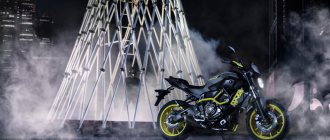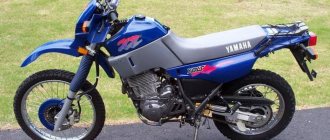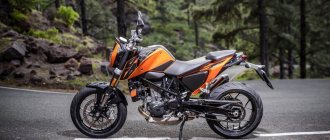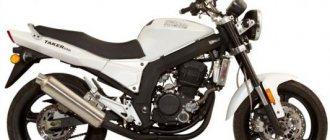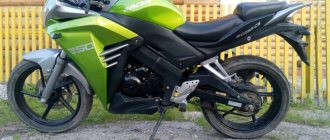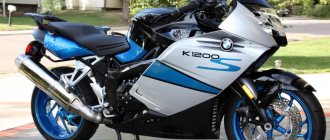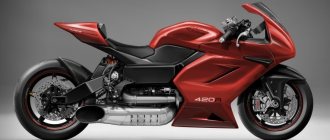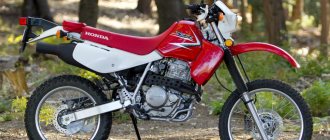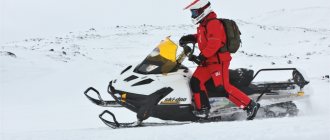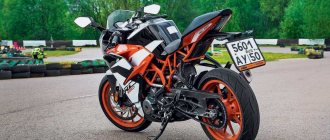In 1989, the Honda PC800 Pacific Coast touring motorcycle was introduced to the global motorcycle community, mass production of which continued until 1998. The model was initially aimed at the North American market, but later began to be offered to motorcycle enthusiasts from Japan and Europe. Over the entire period of serial production of the motorcycle, more than 14 thousand copies were produced.
The PC800 Pacific combines the features of two different bike models - the Honda ST1100 Pan European and the Honda Deauville 650.
Features and review of Honda PC800
The original concept of the motorcycle was quite interesting and was to create a practical bike designed for novice drivers with low maintenance. The engineers of the Japanese company Honda managed to complete the task by creating the Honda PC 800 Pacific - a reliable, practical and easy-to-use model with the following features:
- Good wind protection allows you to travel at high speed in any weather and protects the driver from oncoming air flow.
- Multifunctional dashboard, made in classic automotive style. The display shows information about the condition of the motorcycle.
- Spacious luggage compartment that occupies the entire rear of the motorcycle;
- Models produced between 1989 and 1990 were equipped with an audio system with AM/FM radio support.
- Low-maintenance cardan drive.
- The connection diagram for Honda PC800 turn signals, installed on models before 1997, included an auto-off function.
- A hydraulic clutch is more convenient and lighter than a cable clutch and requires virtually no maintenance.
- There is no need for periodic valve adjustments thanks to the installed hydraulic valve clearance compensators.
Among other features of the Honda PC800, one can note the presence of a full plastic body kit, typical for scooters, and a drum-type rear brake mechanism. Touring versions are equipped with a combined braking system and plastic protection against rain and dirt, which allows you to overcome off-road conditions.
Dimensions and weight
The length of this bike reaches 2290 mm, its width is 820 mm, and its height is 1420 mm. The seat height is 765 mm and the wheelbase is 1555 mm. The curb weight of the PC 800 is 283 kg. The volume of the motorcycle's gas tank is 16 liters, and the consumption per hundred here is around 5 liters.
Engine and technical specifications
Honda PC800 received a V-shaped two-cylinder power unit from another model - Africa Twin 750. Changing the piston stroke of the engine made it possible to increase its displacement to 800 cubic centimeters. At low speeds, the engine maintains smooth thrust, delivering 66 Nm of torque and 57 horsepower. The cooling system is liquid type, three valves are installed on each cylinder, which is typical for all Honda power units with a V-shaped two-cylinder design.
Owners of the Honda PC800 in reviews note the discrepancy between the fuel consumption indicated in the manuals and the real one: for every 100 kilometers the motorcycle consumes 5-6 liters, depending on the driving style, load and technical condition of the motorcycle.
Model history
The first Honda PC800 motorcycles were released in 1989. The previously offered optional AM/FM radio was canceled in 1994, and three years later, in 1997, the automatic turn signal switch-off feature was removed and the front fender was combined with the fairing. In 1998, the motorcycle model was officially discontinued.
Even today a bike can be purchased in good technical condition and without mileage in the Russian Federation for 180-200 thousand rubles. The minimum cost of models with mileage in Russia is 140 thousand rubles.
Chassis and brakes
The bike has a steel duplex frame. This body looks elegant, even slightly sporty. The handlebars and alloy wheels are fairly typical for these bikes. The exterior looks stylish and bright, emphasizing the power and exclusivity of the motorcycle.
At the rear, a pendulum version with two shock absorbers is used as a suspension, and at the front, a 41 mm telescopic fork is used. The PC 800 brakes with a rear drum and a pair of 290 mm front discs along with two-piston calipers. The result of this engineering solution: excellent, sharp braking in front and soft, but quite confident - in the rear. In combination, these brakes provide a smooth, well-controlled reduction in speed.
The legendary PC800 motorcycle
Over the years of mass production, the Honda PC800 touring motorcycle has become a legend, acquiring a large number of fans around the world. The closest relative of the model, on the basis of which it was created, was the no less legendary Honda Africa Twin. It was from this motorcycle that the Honda PC800 inherited the engine and transmission, but in a slightly modified form: the engine displacement was increased by 50 cubic centimeters, the piston stroke increased, which was beneficial. Pacific Coast at minimum torque has excellent traction, which is not inferior to choppers of identical power unit capacity and is maintained after reaching high speed. Throughout the entire rev range, the engine maintains power and traction without the dips or stalls that plague units of many motorcycles in the same class.
For whom
Here are the main features of this model:
- bright design, matching even a sports bike;
- engine and gearbox from “Africa” itself, slightly modified;
- excellent wind protection;
- huge trunk.
The bike is well suited not only for travelers, but also for people who need to get to work, covering tens of kilometers every day. This motorcycle will be a very convenient vehicle for those who simply prefer large bikes, but ride them close.
Transmission and fuel consumption
Inherited from the Africa Twin, the Honda PC800 motorcycle also received a five-speed gearbox, which has undergone certain changes. All gears, with the exception of the very first, are elastic and quite long, which saves the driver from constantly switching them when driving in the city. On the track, the acceleration dynamics of the motorcycle are identical in any gear.
With similar characteristics, the Honda PC800 consumes 5-6 liters of fuel when driving at a speed of 110-120 km/h. The power reserve is limited to a 16-liter fuel tank, which is quite strange for a touring model of a motorcycle. The gas tank is located under the seat, which shifts the center of gravity and makes it easier to control. Despite its considerable weight, the Honda PC800 handles well and listens perfectly to the driver, which was achieved thanks to a competent layout and low center of gravity, which makes it easy to maneuver in dense city traffic at any speed.
Luggage compartment
The ample luggage space is impressive when first checking out the bike and explains why the Honda PC800 didn't get a larger fuel tank. The trunk fits two full-size helmets and other small items necessary for a long trip. The design of the motorcycle allows you to install a central trunk, which will increase the usable volume and serve as an excellent backrest for the passenger.
Owner reviews
Many motorcycle enthusiasts purchase Pacific Coast as an alternative to expensive motorcycle models. The reviews note the following advantages of the bike:
- High, excellent wind protection for a comfortable ride.
- Built-in luggage compartment of large volume, allowing you to carry various loads and two helmets.
- The engine is not picky about gasoline thanks to the compression ratio of 9.0 and can even run on grade 80 fuel.
- Affordable price with a high level of quality.
However, some motorcyclists still refuse to purchase a Honda PC800, since some of its disadvantages outweigh its advantages:
- For dynamic movement, a curb weight of 260 kilograms and an engine with a power of 57 horsepower are frankly not enough - many of the PC800’s classmates have more power.
- The total volume of the fuel tank is 16 liters. Considering the fuel consumption of 5-7 liters, the motorcycle's power reserve is 250 kilometers. Of course, a certain autonomy is still present, but during long trips you will still have to refuel regularly.
- A large amount of plastic in the decoration. Motorcycles offered on the secondary market are very old, which leads to a loss of elasticity of plastic parts and an increase in their fragility. In the absence of proper care, the body kit rattles and vibrates while driving, leaving a not-so-pleasant impression of the trip.
- Lack of tuning options. The only available features for the Honda Pacific Coast are rear and center pannier storage, front fender extensions and tall windshields.
Despite the fact that a touring motorcycle is equipped with a large number of plastic parts, the level of safety for the driver and passenger is quite high. In the event of a fall or collision, the legs are protected by special arches located at a low height under the plastic.
The Honda PC800 touring motorcycle is the best option for long trips and maneuvering in dense city traffic. The model is unpretentious in maintenance, has unsurpassed reliability and high build quality. Plastic body kits are easily repaired if necessary. Spare parts are inexpensive and easily accessible; they can be purchased in specialized stores. The main advantage of a touring motorcycle is, of course, the spacious luggage compartment, which causes pure puppy-like delight among many motorcyclists who encounter the Honda PC800 for the first time. The motorcycle is definitely worth buying: its affordable price, excellent technical characteristics, dynamism and cross-country ability make it the best in its class.
Review of Honda PC 800
Review of Honda Pacific Coast 800.
Pacificas were produced from 1989 to 1998. And for all the time they practically did not change. The power unit in the Pacific is from Africa, devoured to 800cc, which, with the same 55 horses, gives a little more torque. In general, Pacific is 40% African + 40% Shadovka + 20% individuality (yes, “the perfect recipe. Two from Chevrolet, one from Ford...”). The power unit is from Africa, and the rear axle is from the Shadovka. And the individuality is the frame and plastic, which you won’t find... In total, the result is a very good device, which, with little request from the owner, can ride it until old age, because there is a resource there - to the moon and back.
The engine in it, by the way, is not so simple. It has absolutely car speeds, 8000rpm is the maximum speed. And the power is “smeared” over almost the entire range. On the internet, they push it to a maximum of 200 km/h. Which in general seems to be true, because... I accelerated to 160 km/h with number two, and there was still some reserve.
Pacific has excellent wind and moisture protection. When driving in the rain, only your legs from top to knee, helmet, hands on top, wet gloves and toes of shoes are a little wet, because you click the gears and the brake. Otherwise you're dry! Well, or, at least, you feel much more comfortable than lovers of real iron motorcycles.
The Pacifica has a bunch of different pleasant little things that are not visible in all Hondas.
For example, passenger footrests. Carefully made and fit into the design of the motorcycle. Very comfortable and heavy. And not just an iron pipe tightly welded into the frame (but reliably!).
There are holes for drainage in places where water can get in.
Even the battery... By the way! It deserves special attention. The battery is located on the right under the trunk. And there is no way for water to get there. But! Despite this, it is installed in a plastic case, which also has drainage grooves and a drain hole.
Pay attention to the terminals. As you can see, the “+” terminal is installed next to part of the frame. And so that suddenly, when lighting a cigarette (for example), it does not short out, a special casing was made for the frame. The battery is pressed on top so that it does not shake from vibrations... in general - for people.
The trunk fits 2 helmets + a bunch of small items. In general, the trunk is what Pacific drivers yearn for first if they sell it. Because there is nothing like this anywhere. At all. The trunk is the only thing that has the WOW factor in the Pacific. Because when you open the trunk, the uninitiated almost always have the following reaction: “Wait, what do you have, a TRUNK?!?!? NUNI#@I AM FOR MYSELF!” The reaction of the girls is especially pleasing - “Ooooggggoooo.... cool how much you can put... Zaaaaay, zaaay! Let’s buy one for ourselves!” XD
.
And in fact, everything would be good and wonderful, until you start to really think about “what is this spendthrift for? How to use it? And really - how to use a medium-sized tourist? In theory, it should be a universal motorcycle both in the city and on the highway, but “master everywhere, master nowhere.” This is roughly what happens here. In the city it is not very comfortable due to its dimensions in terms of the mirrors (the dimensions, by the way, are the same as on the ST100). I can’t say that I experience wild discomfort and stand in all traffic jams like a car, but I understand perfectly well that it could have been better if it weren’t for the mirrors.
(But if it weren’t for the mirrors, I would have passed)
Speaking of maneuvering in traffic jams. Pacifica has a big ass. And you definitely need to keep an eye on her. Otherwise, it will be unpleasant if you hitch someone’s car with such a “universal shaft.” Nothing critical, a couple of scratches, but embarrassing and unpleasant (tested, alas, personally).
(Disclaimer - all further discussion will be based solely on the dimensions of the pilot - 190 cm / 100 kg. It may be easier for a less tall/heavy pilot, but some subtleties will still remain)
But here we are, breaking out of the stuffy and constricting city onto the highway, driving towards the sunrise/sunset/wind/adventure (underline as appropriate)… we understand that something is wrong here. But here’s what’s wrong here -
The Pacific has an exclusively chopper lineup. V-shaped longitudinal engine, the crankshaft rotates across the axis of the motorcycle, cardan drive and losses in the places of the box-cardan and cardan-reducer. In total this is about 10-15% percent. Subtract from 55hp. 10% or 15%. What will happen? That's the same!
At 5000 rpm, in 5th gear, the engine of this Pepelats accelerates us to 120 km/h. (by the way, a stuffed gearbox from a 1100 Shadik gives +10 km to the speed, and is 1 in 1). And the red zone is with 7500 rpm. And when you are driving in the left lane at 100-120 km/h, and in the right lane everyone is trailing behind a truck at 80 km/h, and suddenly a Meren blinks at you from behind, going 180 km/h, the dilemma begins - to dump and go into the right lane, and then try to get out, or unscrew it?
But you and I remember that this is a V-type? That he doesn’t like it when you turn it... That he will start to eat oil... That the oil can slightly begin to press through the plugs... And if you are with a passenger? What if the bike is still loaded with junk on top? So it turns out that there’s a little bit of pacific everywhere, but nowhere really.
Speaking of birds. Camshaft plugs are the only problem with the Pacific. It's a pain. It is, of course, not as serious as, for example, the 5-valve head of the FZX750, or like the overrunning clutch of the Dredge 1100, or like the second gear of the Zizer, or like the Vulcan 1500 in general, but it is a sore. Pacific tends to leak oil through these plugs. Especially if you try to fall on it. Treatment is simple - replacement and sealant. Yes, and you can pick it up from your car. You’ll just have to select it yourself - the sellers are lazy asses, for the most part they are too lazy to take their butts off the chair and look away from the TV and help the buyer, because it says “let them talk” (!!!). Therefore, an engine in an oil film can be said to be normal)
Its mirrors deserve a separate discussion. Mirrors of the Pacific is exactly the case when there is one step from genius to idiocy.
Mirrors are beautiful because they fit perfectly into the design. The fact that they are also a huge size and turn signal. And thanks to them, you can be seen much better. You can finally see where the motorcycle will turn. Unlike some people who shove the turn signal up their, excuse me, ass, or even better, hang it under the steering wheel (no offense to Harley riders), and then get offended that they weren’t noticed.
The mirrors have an excellent system... Let's call it "breaking off". The point is that the mirror has a double mount. The first is two bolts with which the mirror is screwed to the motorcycle.
And the second is an additional strip inside the case. It is attached to the mirror with 3 bolts. In the holes for attaching these bolts there are flexible petals, which in the normal state tighten the bolt and the mirror does not go anywhere.
But when you cling to the mirror, and so as not to tear out all the meat or destroy the mirror, these petals unclench, release the bolts and the mirror... falls? No! 3rd chip in the mount. It is additionally secured with a metal cable. And it just remains hanging on it. And you, after swearing a little, take out a screwdriver and simply screw everything back. God, this is brilliant...
But here the negative sides begin.
So, in fact, the Pacifica has quite large car mirrors. By the way, they are slightly convex, so it’s just not possible to cut out a piece of glass on it anyhow (or you’ll have to stuff it with mats into an unsuitable case and secure it with glue/tape/chewing gum). And it would seem that such mugs should have a great review, but what the hell! So that you understand how bad the review is here, I’ll tell you as an example - I had mirrors on my steed that I bought for 500 rubles a pair. Like these ones -
They are much smaller, they shook wildly on the highway, because there are no weights inside, and in order to really see something, sometimes you had to press them with your hands to dampen the vibrations. They were so Chinese, in the bad sense of the word, that once a piece of glass simply flew out of the body when I was driving along the highway. And it was much better to see through these mirrors.
1. In the mirrors of the Pacific there is simply a huge “dead zone”. It is so big that when changing lanes you have to look back more often than look forward. And this seems to be curable, people install additional blind spot mirrors and other tuning, but the fact remains a fact.
2. Follows from 1st. In dense city traffic, it’s impossible to quickly change lanes, and instead of changing lanes, you look around 100 times to see if they’re letting you through or if you should continue to catch the bus.
On the crookedly stitched panorama of the review, red lines mark the blind spot.
3. Follows from 2nd. Because you constantly look around, the concentration of attention ahead drops greatly, and at some point you realize that there are only a few meters left to the car ahead. And you have to forget about changing lanes and slow down so as not to run into the ass of the person in front.
4. Due to the fact that the mirrors are located below, and not at eye level, in order to look at them, sometimes even “taking a glance” is not enough. Often you have to tilt your head, completely taking your vision (even peripheral) away from the road ahead. It's a small thing, but unpleasant.
5. Follows from 4th. The location of the mirrors completely kills the ability to navigate by them with peripheral vision. So that you understand how bad everything is - once at night on an empty road, I was driving in the left lane, because... the right one was broken. And then SUDDENLY a distant car blinked at me from behind so that I would let her through, and she was very close, about 200m from me. It appeared, one might say, out of nowhere. Despite all this, I did not sleep and periodically glanced at the mirrors.
Of course, you can criticize for a long time that I’m just crooked-eyed, the mirrors are not adjusted, etc. and so on. but, I think, almost 5 years of accident-free driving still give me the opportunity to somewhat judge the quality of such things.
6. And the most important factor in the problem of Pacific mirrors. Because the past ones can be solved to one degree or another, but this one is not. Just look at the screenshot below -
For comparison, an assembled Pacific engine can be purchased for ~20-40 thousand.
Yes, gentlemen, this is the kind of bullshit that comes out. 2 mirrors will cost ~60 thousand rubles. One mirror is more expensive than a Carl engine! Considering that the price for a Pacific is around 160-200 thousand, then the mirrors cost almost half the cost of the motorcycle. And yes, there are no mirrors on AliExpress, not at all. Funny? No. This is fucked up, comrades.
“Well, perhaps mirrors are not so easy to break? Both the “breaking off” system and the arcs are in the drain. Honda engineers are not idiots." - you say. And in some ways you will probably be right. In general, I’ve been wondering for a long time what kind of intoxicating thing the motorcycle engineers from Japan are smoking...
Speaking of arcs. In Pacific circles they are called “fins”. This is another place on this motorcycle where genius and idiocy come together.
On the one hand, they fit perfectly into the design of the motorcycle, protecting the pilot’s feet from any minor falls, rubbing with the car, and when he “puts the bike down” (everything was checked personally). And at such moments, you, pulling your leg out from under the motorcycle, wearing your expensive Kevlar flip-flops reinforced with scales from the dragon’s ass, lifting the motorcycle, will think to yourself - “God bless Honda engineers.”
But on the other hand, in any fall that causes the motorcycle to fall over the fins, it falls straight onto the mirror. And this, by the way, is at least 260 kg. And under such weight, the mirror can simply crumble into dust. Now remember how much a mirror costs. Now the toad has already woken up...
This is what happens during such falls, at not the highest speeds. Then you have to play the “glue it yourself” constructor game, if, of course, you are lucky and you find all the parts (and this has not been verified by me, fortunately).
And everything might be fine, but this is a touring motorcycle. What should you do if you fall 2000 km from home and break a mirror? If there were ordinary ones there, you could buy any of them in the nearest town for 500 rubles and drive on. And here? It will be uncomfortable with the 1st mirror, let me tell you. Yes, and understand that the cost of the trip has increased sharply by 30 thousand. somehow also unpleasant.
By the way, another fly in the ointment - the mirrors in the Pacifica are exactly at the level of mirrors in 90% of passenger cars. Therefore, there is an opinion that there are no pacifics with living, and never soldered mirrors in our vastness.
Landing. It also contains some surprises. Absolutely straight, with a straight back, no need to slouch (tru chopir), no need to turn into a shrimp (tru sport). You just sit back, ride and enjoy. The huge soft saddle will accommodate any burger-fed ass. And the passenger in the back is like sitting on a chair - you put the backrest and he will fall asleep. You can calmly change positions, get up, put your feet on the fins for a while, or you can put your feet on the fins and ride in a precise posture “on the courts”)) And everything is fine, it seems….
The fact is that when you drive over 100 km/h (my cruiser is 120 km/h), you realize that you are catching all the oncoming winds with your head, and besides this, the stock windshield cuts everything right into your visor. Not pleasant.
(A small note. When the windshield cuts off everything in the visor, there are two contradictory facts. The first is that it’s simply uncomfortable. The second is that if you suddenly get caught in the rain, the air flows cut off by the windshield disperse the drops that collect on the visor and interfere with your view. But speed 100-120 is not enough to clean the visor well, and you still have to wipe it with your hand. And to put more than 120 in the rain... well, your wife must be giving birth/the house is on fire/you are an idiot (underline as appropriate).)
And somehow intuitively I want to bend down slightly and hide behind the windshield. And this is where the suffering begins. The fact is that the steering wheel on the Pacifica is quite high, and with such tilts, your hands rest on the steering wheel and become very tense. You can, of course, try to relax them, but then all the tension will go to your back - it’s your choice). Is it possible to lower the steering wheel? Can! Only the steering wheel in the Pacifica is packed in a plastic casing, and you will have to remove it, which will kill the appearance of the Pacifica.
You can try to put together a casing for a new steering wheel, but then it’s better to immediately turn the Pacific into RAT Style. It won't be so scary.
Further. When we bend over, the most unpleasant thing happens - our arms bend at the elbows in such a position that they completely block the view in the mirrors, so we have to press them closer to ourselves, which makes such a landing ultimately fucking, oh, excuse me, uncomfortable!
In general, I was thinking about where it would be convenient for me to place my hands with such a landing, and it turned out that this is where -
Yes, yes, exactly in the place where the clip-ons are located on sport-touring motorcycles like the same one. The back, of course, is still tense, but it’s much easier, and the hands are a pleasure, and don’t interfere with the mirrors.
In general, purely theoretically, this whole problem can be solved by simply installing an additional screen on the windshield.
I would like to remind you that I am 190cm tall. If you are shorter, you may not have to experience such inconvenience. But for some reason those who are lower also install a windshield... (I’m so “surprised” why that I don’t know how to joke...)
Cooling. As you all have noticed, the Pacific is completely wrapped in plastic. And the 800 cc engine already has quite an adult heat transfer. And it gets pretty warm. But the most interesting thing can be seen if you look inside, behind the “gill” -
Do you see the yellow stuff? This is a “thermal jacket”. The rear part of the engine is wrapped in it, or rather the rear cylinder (which, poor fellow, in V-shapes suffers from poor cooling). This was done so that on a hot day, if you get stuck in a traffic jam, the engine will not set your crotch on fire. The other side of this coin is the strong heating of the engine. Let me clarify - HEATING, not OVERHEATING. I didn't have the engine boil over. Although in the city the fan works regularly, even at +5 (here I went nuts), and it still copes.
If you still have problems with cooling, don’t rush to say that the motorcycle is crap. Overheating may be caused by a clogged radiator, which, by the way, is a common problem in 80% of motorcycles, not just Pacificas.
This picture is the norm. It can be treated by installing an extended front wing.
One Pacific driver was so upset with his cooling and the constant operation of the fan that he decided to build an additional radiator on the collective farm. To which he was offered to start by flushing the original radiator inside and out, and changing the antifreeze. And voila! The problems never happened.
Rubber. This is the only thing I can seriously classify as a “motorcycle problem”. Rear size 140/80-15(16), this is a very rare size. They are made by a couple of companies at exorbitant prices. As far as I know, these are metzeller, dunvlob and shinka. You can, of course, try to pick one up. For example, I have 150/80.
After surfing the Internet, this is what I found -
Metzeler (what a name...if you say it in a public place, you’ll also get tied up for promoting fascism...). Price tag from 10 thousand.
Dunvlob. Very popular tires for this motorcycle. But they scold because... when the temperature drops it becomes simply oaky.
But I couldn’t find a tire. But they say the price tag starts from 7,000 rubles.
Consumption. The motorcycle's consumption is about 5-6l. at 100 km with quiet driving. You will fry for all the money, I think it can show 10k. The tank is located under the saddle, with a volume of 16 liters, not very serious for a tourist... It lasts for 250-300 km, which is an average. In our region, where gas stations are located on every corner, any problems that arise from the small volume of a gas tank are not noticeable at all. But frequent refueling is starting to get boring...
And under the false tank there is an air filter, under it there are carbs, and cylinder heads. It’s not difficult to get to all this, which is a clear plus for the Honda engineer.
There is also a problem with attaching a phone to a motorcycle. Why? Because “where?” Where should I attach this damn phone? On the steering wheel? There is a casing, because of which a standard magazine mount will not fit at all. Suction cup for windshield? Well, he’ll come off the vibration or some bump and immediately turn off the phone. For a false tank? Where are you going to throw your motorcycle bag? But I just want everything to be in its place...
“So what happens, the motorcycle is crap?” - you say. “No, the motorcycle is quite good!” - I will answer.
Above, I simply described in vivid colors what the future owner of a Pacific car will most likely have to face. In all other respects, the motorcycle will delight the owner.
Take at least the oil drain bolt. Finally, it is located in an adequate place, and not in the ass of a motorcycle, where you can’t get close without huddling over and going through 20 options. It is located just below. Covered with safety ribs. When I changed the oil and saw this I almost cried with happiness...
I would also like to say something about the side step. I don’t know whether it was specially developed or whether it happened by chance, but this is exactly the case when the side step stands adequately, in its place, and opens intuitively with one simple movement of the foot. It’s just that there are a lot of motorcycles where the footrest is located like hell, and in order to open it you need to have the leg of a 10-year-old Japanese girl, because the size 45 of a normal Russian man simply won’t fit there.
There are heaps of spare parts for it. Pacifics are often dismantled. We have already learned how to make plastic linings for fins. And you can simply pick up 70% of spare parts from other Hondas. The only universal ones will be plastic and a piston with a crankshaft (probably). Well, or just remember how much the assembled engine costs...
Speaking of tuning. There is no aftermarket for this motorcycle. At all. Only a high windshield. And he looks scary. Because everything you do will be done with your own hands. And the topic of tuning the Pacifica is for another review because... it is vast and endless as the topic of gold tuning.
Also in the Pacific there is an anti-peck. Very cool thing! Its essence is that when you suddenly release the gas, the front fork does not load and the motorcycle does not “peck” its muzzle. Now think about which budget tourists have you seen this happen to? What about motorcycles in general?
By the way, the Pacific has no adequate cardan competitors. Neither in price nor in class at all. All sorts of fifers and katanas can generally not be taken into account, if only because there is much more “sport” in a motorcycle than “tourist”. Honda has firmly taken the place of medium-sized tourists with its Pacifics and Devils.
Who is this motorcycle for? This motorcycle is for two categories of people.
1. Those who want to try what a tourist is. What is good wind and moisture protection? What is it like when in the rain your feet are not dirty from ear to ear? What is it like to always have a trunk? What is motorcycle riding comfort? And all this for relatively little money.
2. Those who specifically need a medium-sized tourist. Who drives the city highway? Who doesn't have to shell out money for everyone? Who travels in “retirement” mode? Who travels long distances without particularly rushing? Who just doesn't need 100+ mares between their legs and 50 to 160 in 3 seconds.
And by no means is Pacific for beginners. Not because he is evil or difficult to control. He is very predictable and soft. Because newbies fall. And just remember the price of the mirror...
To summarize, I can say that the Pacific is a very good and reliable motorcycle, which is valued in its circles. And if you are not afraid of the problems that I have listed, if you fit into one of the above mentioned categories, you can safely buy this device. He won't disappoint you.
Also, many thanks to the group of pacificophiles on VK, from where I honestly stole a couple of photos without asking.
https://vk.com/pc800
Tags
- pacific
- pc800
- review
